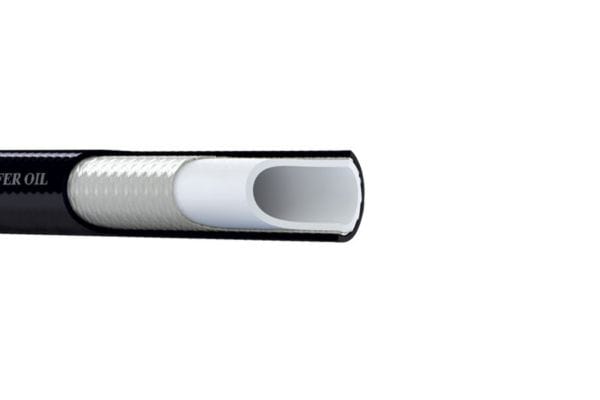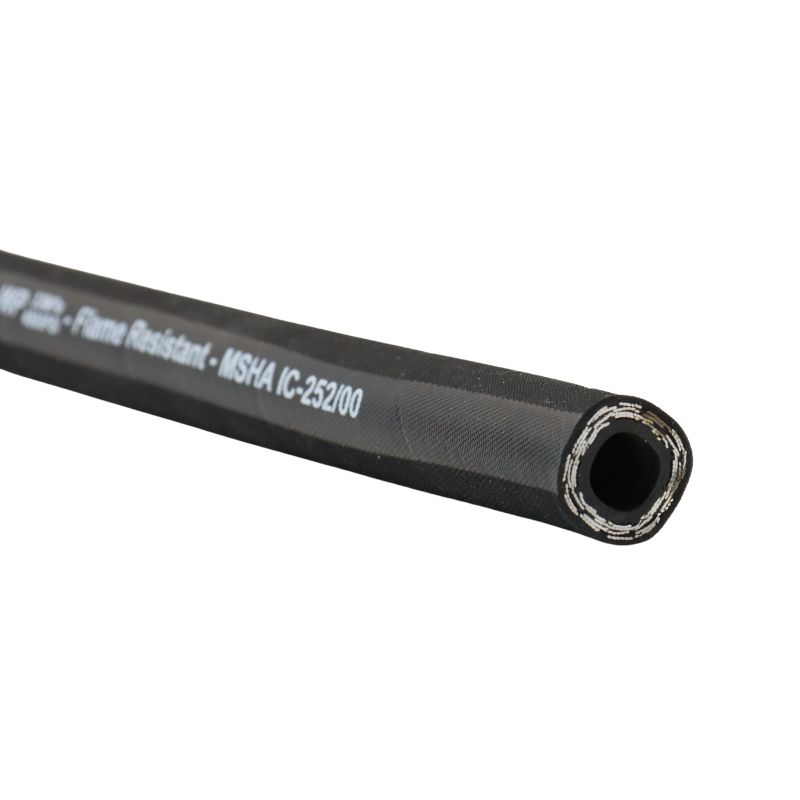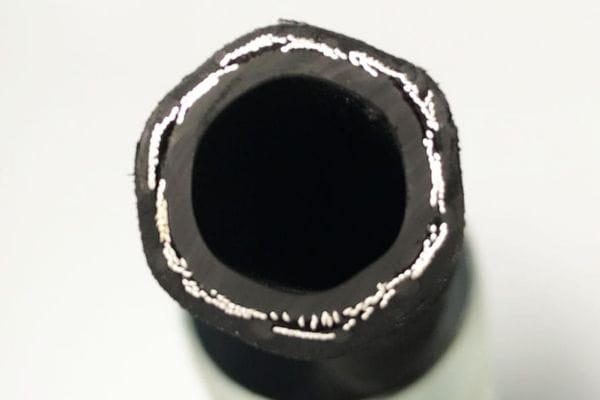Hydraulic hoses are crucial components in hydraulic systems, serving as conduits for transmitting fluid power under high pressure. These hoses are designed to withstand demanding conditions and ensure efficient fluid transfer, making them essential for the smooth operation of various machinery and equipment. Their construction and material properties determine their suitability for different applications, impacting performance and safety.
Understanding Hydraulic Hoses
What is a Hydraulic Hose?
A hydraulic hose is a flexible tube used to transmit hydraulic fluid between components in a hydraulic system. Its primary purpose is to facilitate the movement of fluid under high pressure, which powers machinery and equipment. Hydraulic hoses are designed to handle the forces exerted by the fluid, ensuring efficient and safe operation of hydraulic systems.
Definition and Purpose in Hydraulic Systems
Hydraulic hoses are critical for delivering pressurized fluid to various system components, such as cylinders, pumps, and valves. They enable the transfer of hydraulic energy, which is converted into mechanical force to drive machinery or perform specific tasks. Their flexibility allows for the routing of fluid through complex configurations, accommodating the movement and vibration of machinery while maintaining a sealed environment to prevent leaks.

Basic Components and Construction
A hydraulic hose typically consists of three main components:
Inner Tube: The innermost layer that comes into direct contact with the hydraulic fluid. It is usually made from rubber or synthetic materials designed to resist corrosion and abrasion.
Reinforcement: The middle layer provides strength and durability. It can consist of one or more layers of steel wire braid, spiral wire, or textile fibers, depending on the hose’s pressure rating and flexibility requirements.
Outer Cover: The outermost layer protects the hose from external factors such as abrasion, weather, and chemicals. It is generally made from rubber or synthetic materials that offer resistance to environmental conditions.
How They are Classified Based on Construction and Reinforcement
Hydraulic hoses are classified primarily by their construction and reinforcement, which determine their pressure ratings, flexibility, and durability. The classification is usually done according to industry standards such as SAE (Society of Automotive Engineers) or ISO (International Organization for Standardization).
Single-Wire Braid Hoses (e.g., R1): These hoses have a single layer of steel wire braid for reinforcement, making them suitable for medium-pressure applications where flexibility and moderate strength are required.
Double-Wire Braid Hoses (e.g., R2): These hoses feature two layers of steel wire braid for enhanced strength and durability, designed to handle high-pressure environments and heavy-duty applications.
Spiral-Wire Hoses: These hoses use multiple layers of spiral-wound steel wire for extreme pressure and flexibility requirements, typically used in very demanding hydraulic systems.
Detailed Breakdown of R1 Hydraulic Hose
Construction and Design
Description of R1 Hose Construction: The R1 hydraulic hose is designed with a single-wire braid reinforcement, which consists of a single layer of steel wire woven around the inner tube. This braid provides structural strength and durability, making the hose suitable for medium-pressure applications. The construction allows for flexibility and ease of installation, as the single-wire braid can accommodate a range of bending radii.
Materials Used:
Inner Tube: The inner tube is made from a variety of rubber or synthetic compounds, such as nitrile or neoprene, which are chosen for their resistance to hydraulic fluids and ability to handle pressure without degradation.
Reinforcement: The single-wire braid is typically composed of high-tensile steel wire, providing the necessary strength to withstand pressure and prevent hose failure.
Outer Cover: The outer layer is made from durable rubber or synthetic materials designed to resist abrasion, weathering, and exposure to chemicals. Common materials include neoprene, EPDM, or synthetic rubber.

Specifications
Pressure Rating: The R1 hose is designed to handle medium pressure, typically ranging from 1,000 to 3,000 psi (pounds per square inch). The exact pressure rating depends on the hose’s diameter and construction quality. It is essential to choose an R1 hose that matches the pressure requirements of the hydraulic system to ensure reliable performance.
Temperature Range: R1 hoses generally operate effectively within a temperature range of -40°C to +100°C (-40°F to +212°F). This temperature range ensures the hose maintains its flexibility and performance under various operating conditions. However, specific temperature limits can vary based on the materials used and the hydraulic fluids being transported.
Flexibility and Bend Radius: The single-wire braid construction of the R1 hose allows for moderate flexibility and bending capabilities. The minimum bend radius for an R1 hose is usually around 4 to 6 times the hose’s diameter, depending on the hose’s size and construction. This flexibility makes the R1 hose suitable for applications where some degree of movement and maneuverability is required.
Applications
Typical Use Cases and Industries: R1 hydraulic hoses are commonly used in various industries where medium-pressure hydraulic systems are employed. Typical applications include:
Agriculture: Used in hydraulic systems of tractors and other farm equipment.
Construction: Applied in hydraulic machinery such as excavators, backhoes, and loaders.
Manufacturing: Utilized in hydraulic presses, conveyors, and other machinery.
Automotive: Found in hydraulic systems of automotive lifts and machinery.
Advantages and Limitations
Pros of Using R1 Hoses:
Cost-Effective: Generally less expensive than high-pressure hoses due to simpler construction.
Flexibility: Provides good flexibility and ease of installation in medium-pressure applications.
Durability: Offers reliable performance for less demanding environments with moderate pressure requirements.
Wide Availability: Commonly available and widely used in various industries, making it easy to source replacements.
Potential Drawbacks and Limitations:
Pressure Limitations: Not suitable for high-pressure applications where R2 or spiral-wire hoses would be more appropriate.
Limited Temperature Range: This may not perform well under extreme temperature conditions compared to hoses designed for broader ranges.
Reduced Strength: The single-wire braid provides less reinforcement compared to double-wire or spiral-wire hoses, potentially limiting its use in high-stress applications.
Wear and Tear: The outer cover may be less resistant to certain chemicals or severe environmental conditions, leading to potential degradation over time.
Detailed Breakdown of R2 Hydraulic Hose
Construction and Design
Description of R2 Hose Construction: The R2 hydraulic hose is engineered with a double-wire braid reinforcement, which consists of two layers of steel wire woven around the inner tube. This double-braid construction provides enhanced strength and durability, making the hose suitable for high-pressure applications. The additional layer of steel wire offers superior resistance to pressure and external damage, allowing the R2 hose to handle more demanding operational conditions compared to its single-wire counterparts.
Materials Used:
Inner Tube: The inner tube is crafted from rubber or synthetic compounds such as nitrile or synthetic rubber, selected for their excellent resistance to hydraulic fluids and high pressure. These materials ensure that the hose maintains its integrity and performance under pressure.
Reinforcement: The double-wire braid consists of high-tensile steel wires that provide exceptional strength and durability. The double layer of braid ensures the hose can withstand higher pressures and stresses, minimizing the risk of failure.
Outer Cover: The outer layer is made from robust rubber or synthetic compounds designed to withstand abrasion, weathering, and exposure to chemicals. Materials like neoprene or EPDM are commonly used to protect the hose from external damage and extend its lifespan.

Specifications
Pressure Rating: R2 hydraulic hoses are designed to handle higher pressures compared to R1 hoses. They typically have a pressure rating ranging from 2,000 to 5,000 psi (pounds per square inch), depending on the hose size and construction. This high pressure rating makes R2 hoses suitable for more demanding hydraulic systems where high pressure is a regular requirement.
Temperature Range: The R2 hose generally operates effectively within a temperature range of -40°C to +100°C (-40°F to +212°F). This temperature range ensures that the hose remains flexible and functional in a variety of operational environments. In some cases, specialized R2 hoses may be available for extended temperature ranges, depending on the materials used.
Flexibility and Bend Radius: Despite its robust double-wire braid construction, the R2 hose still offers good flexibility. The minimum bend radius is typically around 5 to 8 times the hose’s diameter, which provides a balance between strength and maneuverability. This flexibility allows for installation in tight spaces while maintaining durability under high-pressure conditions.
Applications
Typical Use Cases and Industries: R2 hydraulic hoses are widely used in industries where high-pressure hydraulic systems are common. Typical applications include:
Construction: Essential in hydraulic machinery like excavators, bulldozers, and cranes, where high-pressure operations are standard.
Mining: Used in mining equipment such as drills and loaders that operate under high pressure.
Oil and Gas: Applied in hydraulic systems for drilling rigs and other equipment requiring high-pressure hoses.
Manufacturing: Utilized in hydraulic presses and heavy machinery that demand higher pressure capabilities.
Advantages and Limitations
Pros of Using R2 Hoses:
High Pressure Resistance: Capable of handling significantly higher pressures compared to R1 hoses, making them suitable for more demanding applications.
Enhanced Durability: The double-wire braid provides superior strength and resistance to external damage, extending the hose’s lifespan.
Flexibility: Maintains good flexibility while offering high-pressure performance, allowing for easier installation in various configurations.
Safety: Reduced risk of hose failure under high-pressure conditions, which enhances operational safety and reliability.
Potential Drawbacks and Limitations:
Cost: Generally more expensive than R1 hoses due to the additional reinforcement and construction complexity.
Bend Radius: While flexible, the minimum bend radius is larger compared to R1 hoses, which may limit installation in very tight spaces.
Weight: The additional layer of steel braid adds to the weight of the hose, which may be a consideration in applications where hose weight is a factor.
Temperature Sensitivity: While the standard temperature range is broad, extreme temperatures may still affect performance, particularly if the hose is exposed to conditions outside its specified range.
Hydraulic Hose Types
1SN Hydraulic Hose
Construction and Design:
Reinforcement: The 1SN hose is a single-wire braid hose with one layer of steel wire braid reinforcement.
Materials Used: The inner tube is typically made from synthetic rubber or a blend of rubber compounds, while the outer cover is made from durable rubber or synthetic materials to protect against environmental factors.
Specifications:
Pressure Rating: Typically up to 3000 psi, though the exact rating can vary based on hose diameter and construction.
Temperature Range: Generally operates between -40°C to +100°C (-40°F to +212°F).
Flexibility and Bend Radius: Offers good flexibility with a minimum bend radius around 4 to 6 times the hose diameter.
Applications:
Commonly used in hydraulic systems where medium pressure is required, such as in agricultural machinery, construction equipment, and industrial machinery.
Advantages and Limitations:
Advantages: Cost-effective, flexible, and suitable for moderate pressure applications.
Limitations: Not suitable for high-pressure applications and may have limited resistance to harsh environmental conditions compared to more reinforced hoses.
1SC Hydraulic Hose
Construction and Design:
Reinforcement: Similar to the 1SN hose but with a slightly different construction, the 1SC hose is also a single-wire braid hose, typically used for similar applications.
Materials Used: The inner tube and outer cover materials are similar to those used in the 1SN hose.
Specifications:
Pressure Rating: Usually comparable to or slightly different from the 1SN hose, up to around 3000 psi.
Temperature Range: Operates effectively within a similar temperature range as the 1SN hose.
Flexibility and Bend Radius: Flexibility and bend radius are similar to those of the 1SN hose.
Applications:
Used in similar applications to the 1SN hose, including hydraulic machinery and equipment that operate under medium pressure.
Advantages and Limitations:
Advantages: Similar to the 1SN hose, providing flexibility and cost-efficiency.
Limitations: Similar to the 1SN hose, with potential limitations in pressure capacity and environmental resistance.
2SN Hydraulic Hose
Construction and Design:
Reinforcement: The 2SN hose features double-wire braid reinforcement, providing two layers of steel wire braid for enhanced strength and durability.
Materials Used: The construction materials are similar to those of the 1SN hose, with an additional layer of steel braid for increased pressure resistance.
Specifications:
Pressure Rating: Typically higher than the 1SN hose, with ratings up to 5000 psi or more depending on the hose size and construction.
Temperature Range: Operates within a similar temperature range as the 1SN hose, though some specialized versions may offer different ranges.
Flexibility and Bend Radius: The additional reinforcement can affect flexibility, with a minimum bend radius usually around 5 to 8 times the hose diameter.
Applications:
Ideal for high-pressure hydraulic systems, such as in construction equipment, mining machinery, and high-pressure industrial applications.
Advantages and Limitations:
Advantages: Higher pressure resistance and durability, suitable for demanding applications.
Limitations: Higher cost and potentially less flexibility compared to single-wire braid hoses.
2SC Hydraulic Hose
Construction and Design:
Reinforcement: Similar to the 2SN hose, the 2SC hose also has double-wire braid reinforcement but may have slight differences in construction or material specifications.
Materials Used: The materials used for the inner tube and outer cover are similar to those in the 2SN hose.
Specifications:
Pressure Rating: Comparable to or slightly different from the 2SN hose, with high-pressure ratings up to around 5000 psi.
Temperature Range: Operates within a similar temperature range as the 2SN hose.
Flexibility and Bend Radius: Flexibility and bend radius are similar to those of the 2SN hose, though the additional braid may affect flexibility slightly.
Applications:
Used in high-pressure hydraulic systems where durability and strength are required, such as in heavy machinery and industrial applications.
Advantages and Limitations:
Advantages: Enhanced pressure capacity and durability, suitable for high-stress environments.
Limitations: Similar to the 2SN hose, with potential trade-offs in flexibility and increased cost.
Expert Recommendations
When to Choose R1
Scenarios Where R1 is the Preferred Choice:
Medium-Pressure Applications: R1 hoses are ideal for hydraulic systems operating under medium pressure, typically up to 3000 psi. They are well-suited for applications where the pressure demands are moderate and do not exceed the hose’s rated capacity.
Cost-Conscious Projects: Due to their simpler construction with a single-wire braid, R1 hoses are more cost-effective compared to higher-pressure hoses. They are a good choice for projects with budget constraints but still require reliable performance.
Flexibility Needs: In situations where flexibility and ease of installation are crucial, the R1 hose’s design offers good maneuverability and a relatively small bend radius, making it suitable for applications with limited space or complex routing.

When to Choose R2
Scenarios Where R2 is the Better Option:
High-Pressure Applications: R2 hoses are designed to handle higher pressures, typically up to 5000 psi. They are essential in hydraulic systems where high pressure is a regular requirement, such as in heavy machinery, construction equipment, and high-pressure industrial processes.
Durability Requirements: When the application demands superior durability and strength, the double-wire braid reinforcement of the R2 hose provides enhanced resistance to pressure and external damage. This makes R2 hoses suitable for environments where hoses are subject to heavy wear and tear.
High-Stress Environments: For operations in harsh conditions or where the hydraulic system experiences high stresses, R2 hoses offer better performance and safety due to their robust construction and higher pressure rating.
Tips for Selecting the Right Hose
Factors to Consider When Choosing Between R1 and R2:
Pressure Requirements: Assess the maximum operating pressure of your hydraulic system. Choose R1 for moderate pressure needs and R2 for high-pressure applications.
Flexibility vs. Strength: Determine if flexibility or strength is more critical for your application. R1 hoses offer greater flexibility, while R2 hoses provide higher strength and durability.
Cost vs. Performance: Balance your budget with performance needs. R1 hoses are more cost-effective but less suited for high-pressure environments, whereas R2 hoses offer enhanced performance at a higher cost.
Conclusion
Choosing the right hydraulic hose is critical to ensuring optimum performance and longevity of your hydraulic system. r1 and r2 hoses have different uses and choosing the right type for your specific needs can have a significant impact on system efficiency and safety. Before making a final decision, consult a hydraulics specialist or supplier to understand your specific requirements and ensure that you select the hose best suited to your application.
FAQ
What is the main difference between R1 vs R2 hydraulic hoses?
R1 hoses have a single-wire braid reinforcement and are suited for medium-pressure applications, while R2 hoses feature a double-wire braid for higher pressure and increased durability.
Can I use an R1 hose in a high-pressure system?
No, R1 hoses are designed for medium-pressure applications. For high-pressure systems, an R2 hose is recommended due to its higher pressure rating and reinforced construction.
What are the typical applications for R1 hydraulic hoses?
R1 hoses are commonly used in agricultural machinery, construction equipment, and industrial machinery where medium pressure and flexibility are required.
How does the flexibility of R1 compare to R2 hoses?
R1 hoses are generally more flexible and have a smaller bend radius compared to R2 hoses, making them suitable for applications requiring tighter bends and maneuverability.
What is the pressure rating of an R2 hydraulic hose?
R2 hoses typically have a pressure rating up to 5000 psi, depending on the hose size and construction, making them suitable for high-pressure hydraulic systems.
How do I choose between R1 and R2 hoses?
Choose R1 for medium-pressure applications where flexibility and cost are priorities. Opt for R2 when dealing with high-pressure systems that require greater durability and strength. Consult with experts to match the hose to your specific needs.





